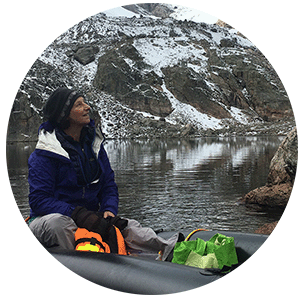Last updated: November 7, 2022
Article
Nutrients and warming alter mountain lake benthic algal structure and function
Read the Paper Here
Sky Pond is one of three alpine lakes in the Loch Vale Watershed. Like many alpine lakes in RMNP, Sky Pond was categorized historically as an oligotrophic lake. Oligotrophic lakes are oxygen-rich, nutrient-poor, with very low algal productivity that coincide with clear water and minimal aquatic vegetation. Crystal clear oligotrophic lakes provide habitat for species, such as trout, and serve as sources of high-quality drinking water for downstream communities.

NPS Photo/I. Oleksy
These findings suggest that ecological communities and processes in alpine lakes are shifting in response to climate-driven warming and nutrient increases; overtime, this could lead to larger algal blooms, reduced lake clarity, and changes in water quality.
This project is funded in part by Rocky Mountain Conservancy as part of the Bailey Research Fellowship Program.
Meet the Scientists

transformation of nutrients through watersheds and into lakes. She currently works as a postdoctoral researcher at the University of Wyoming and lives in Fort Collins, Colorado.
"Long-term datasets allow us to tease apart the natural variability of ecosystem processes from that caused by human disturbances, like regional air pollution and global climate change. The beauty of these datasets is that they only become more valuable as time goes on. The insights scientists gain from long-term datasets ultimately deepen our understanding of the causes underpinning ecological change everywhere."

"Our public lands are precious for the environments they preserve and the spiritual renewal they provide to those who venture into them, and even for those who can’t visit but simply know they are there. Resource management that builds from a foundation of scientific knowledge, including patient long-term observations of natural change, is essential to helping our beloved mountains adapt to rapidly changing conditions."
